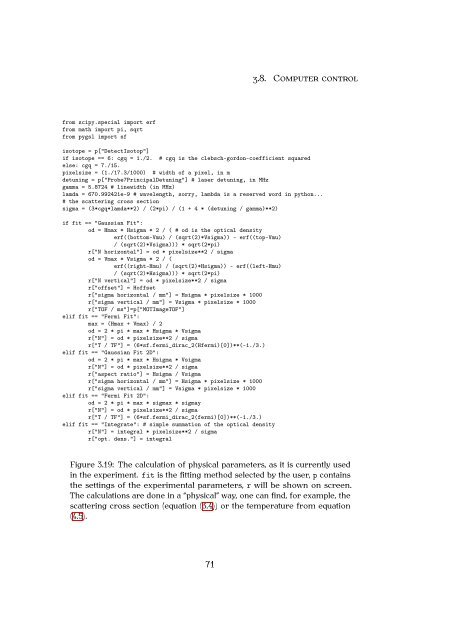Martin Teichmann Atomes de lithium-6 ultra froids dans la ... - TEL
Martin Teichmann Atomes de lithium-6 ultra froids dans la ... - TEL
Martin Teichmann Atomes de lithium-6 ultra froids dans la ... - TEL
Create successful ePaper yourself
Turn your PDF publications into a flip-book with our unique Google optimized e-Paper software.
from scipy.special import erf<br />
from math import pi, sqrt<br />
from pygsl import sf<br />
3.8. COMPUTER CONTROL<br />
isotope = p["DetectIsotop"]<br />
if isotope == 6: cgq = 1./2. # cgq is the clebsch-gordon-coefficient squared<br />
else: cgq = 7./15.<br />
pixelsize = (1./17.3/1000) # width of a pixel, in m<br />
<strong>de</strong>tuning = p["Probe7PrincipalDetuning"] # <strong>la</strong>ser <strong>de</strong>tuning, in MHz<br />
gamma = 5.8724 # linewidth (in MHz)<br />
<strong>la</strong>mda = 670.992421e-9 # wavelength, sorry, <strong>la</strong>mbda is a reserved word in python...<br />
# the scattering cross section<br />
sigma = (3*cgq*<strong>la</strong>mda**2) / (2*pi) / (1 + 4 * (<strong>de</strong>tuning / gamma)**2)<br />
if fit == "Gaussian Fit":<br />
od = Hmax * Hsigma * 2 / ( # od is the optical <strong>de</strong>nsity<br />
erf((bottom-Vmu) / (sqrt(2)*Vsigma)) - erf((top-Vmu)<br />
/ (sqrt(2)*Vsigma))) * sqrt(2*pi)<br />
r["N horizontal"] = od * pixelsize**2 / sigma<br />
od = Vmax * Vsigma * 2 / (<br />
erf((right-Hmu) / (sqrt(2)*Hsigma)) - erf((left-Hmu)<br />
/ (sqrt(2)*Hsigma))) * sqrt(2*pi)<br />
r["N vertical"] = od * pixelsize**2 / sigma<br />
r["offset"] = Hoffset<br />
r["sigma horizontal / mm"] = Hsigma * pixelsize * 1000<br />
r["sigma vertical / mm"] = Vsigma * pixelsize * 1000<br />
r["TOF / ms"]=p["MOTImageTOF"]<br />
elif fit == "Fermi Fit":<br />
max = (Hmax + Vmax) / 2<br />
od = 2 * pi * max * Hsigma * Vsigma<br />
r["N"] = od * pixelsize**2 / sigma<br />
r["T / TF"] = (6*sf.fermi_dirac_2(Hfermi)[0])**(-1./3.)<br />
elif fit == "Gaussian Fit 2D":<br />
od = 2 * pi * max * Hsigma * Vsigma<br />
r["N"] = od * pixelsize**2 / sigma<br />
r["aspect ratio"] = Hsigma / Vsigma<br />
r["sigma horizontal / mm"] = Hsigma * pixelsize * 1000<br />
r["sigma vertical / mm"] = Vsigma * pixelsize * 1000<br />
elif fit == "Fermi Fit 2D":<br />
od = 2 * pi * max * sigmax * sigmay<br />
r["N"] = od * pixelsize**2 / sigma<br />
r["T / TF"] = (6*sf.fermi_dirac_2(fermi)[0])**(-1./3.)<br />
elif fit == "Integrate": # simple summation of the optical <strong>de</strong>nsity<br />
r["N"] = integral * pixelsize**2 / sigma<br />
r["opt. <strong>de</strong>ns."] = integral<br />
Figure 3.19: The calcu<strong>la</strong>tion of physical parameters, as it is currently used<br />
in the experiment. fit is the fitting method selected by the user, p contains<br />
the settings of the experimental parameters, r will be shown on screen.<br />
The calcu<strong>la</strong>tions are done in a “physical” way, one can find, for example, the<br />
scattering cross section (equation (3.4)) or the temperature from equation<br />
(4.5).<br />
71

















